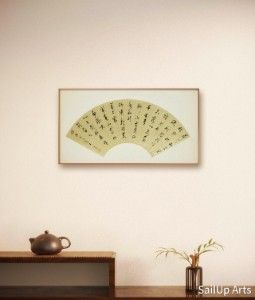


Artwork viewer
Click the image to view a larger version.
Running Script Fan "Two Poems by Tang Dynasty Poet Shi Jianwu" (行書扇面“唐施肩吾詩二首”)
Zhu Angzhi 朱昂之
$3,900.00
Created in The 1800s
Ink on paper 紙本墨書
Mounted, without frame
Dimensions
Image: 28 cm x 53 cm (11" x 20 7/8")
Overall: 32.5 cm x 59.5 cm (12 13/16" x 23 7/16")
Excluding taxes: The price does not include purchase tax, value-added tax (VAT), or other taxes.Learn More
Free Shipping. We will contact you after your purchase to arrange shipping.Learn More
Artist
Zhu Angzhi 朱昂之
1764 - post 1841
Zhu Angzhi, courtesy name Qingli, also known as Jinli, was a native of Wujin, Jiangsu Province. In his later years, he resided in Wuzhong (modern-day Suzhou, Jiangsu). The son of the renowned Qing Dynasty calligrapher and painter Zhu Wenrong, Zhu Angzhi was deeply influenced by his family’s artistic traditions from a young age and excelled in both calligraphy and painting. Drawing inspiration from artists such as Yun Shouping and Wang Hui, he inherited traditional techniques while developing his own distinctive style. Zhu Angzhi was celebrated for his mastery in both calligraphy and painting. His calligraphy is characterized by vigorous and graceful strokes, blending elegance with individuality. His paintings, primarily landscapes, feature meticulous brushwork and a refined aesthetic, emphasizing the harmony between composition and artistic conception. During his middle years, Zhu Angzhi devoted himself to copying works of ancient masters, showcasing his profound artistic cultivation and technical expertise. As a Qing Dynasty literati, Zhu Angzhi upheld the ideal of integrating poetry, calligraphy, and painting into a unified form of artistic expression. His works, particularly his fan calligraphy and landscape paintings, were highly regarded and cherished by scholars and collectors. Zhu Angzhi’s artistic achievements not only reflect the refined beauty of traditional Qing Dynasty art but also leave a rich cultural legacy for future generations.
朱昂之,字青立,又字津里,江蘇武進人,晚年僑居吳中(今江蘇蘇州)。他是清代著名書畫家朱文嶸之子,自幼浸染家學,頗得書畫之妙。朱昂之的藝術造詣青出於藍,深受恽壽平與王翬的影響,並在繼承傳統的基礎上形成了自己獨特的書畫風格。 朱昂之以書畫並重著稱,其書法筆意勁峭,脫盡常規,線條靈動中蘊含力量,風格典雅而不失個性。其繪畫作品多以山水為題材,筆法工整秀美,注重構圖與意境的結合,深得古人神髓,尤其在中年時臨摹古人之作,顯示出極高的藝術修養與技法功底。 作為清代文人,朱昂之崇尚詩書畫三者合一的藝術理想,他的扇面書法和山水畫作品尤為出色,常被文人雅士珍藏。其藝術成就不僅體現了清代傳統書畫的典雅之美,也為後世留下了豐富的文化遺產。
Details
Inscription
聲聲扣出碧琅玕,能使秋猨欲呌難。詩興未窮心更逺,手垂青拂向雲看。 灑水初晴物候新,飡霞閣上最宜春。山花四面風吹入,為我鋪牀作錦茵。 為侶卿大兄先生,昂之
Seal
1 seal of the artist, 昂之
Condition
The artwork is in excellent condition, though it shows signs of aging.
Description
This fan-shaped calligraphy piece by Zhu Angzhi features two seven-character poems by the Tang dynasty poet Shi Jianwu, serving as a quintessential example of the fusion between his calligraphic artistry and poetic sentiment. As a renowned painter and calligrapher of the Qing dynasty, Zhu Angzhi benefited from familial artistic traditions and was profoundly influenced by Yun Shouping and Wang Hui. His calligraphy is characterized by vigorous strokes and a unique style that transcends conventional norms. This piece vividly reflects these artistic attributes. The fan employs running script (xingshu), showcasing fluid yet steady brushwork that demonstrates the calligrapher's exquisite control of lines. The dynamic changes in stroke pressure create a refreshing visual effect, with the overall flow of the brushstrokes exuding rhythm and grace. Particularly in the rendering of phrases like "autumn frost" and "white clouds," the composition captures both the liveliness of running script and the structural rigor, fully embodying Zhu Angzhi's profound mastery of brush and ink. From a compositional perspective, the fan achieves a balance between compactness and well-spaced arrangement. The variation in character spacing and line intervals avoids monotony while enhancing the aesthetic resonance of the poetry. The size and weight of the characters shift with the rhythm of the verses, creating a harmonious interplay between poetry and calligraphy. The fan as a medium itself is a unique form of Chinese calligraphy, and Zhu Angzhi demonstrates exceptional skill in navigating the constraints of this limited space, showcasing his remarkable artistic accomplishments. In summary, Zhu Angzhi's fan-shaped calligraphy piece seamlessly merges the poetic imagery of Tang poetry with the artistic expression of calligraphy. It not only highlights his profound skill but also reflects the Qing literati's ideal of uniting poetry and calligraphy, making it a highly valuable and appreciable work of art.
$3,900.00


